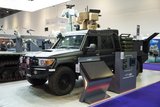Harris Corporation receives $14.4m RF-310M-HH radio order
Harris Corporation, an international communications and information technology company, has received a $14.4 million order to provide additional RF-310M-HH handheld tactical radios for improved secure communications interoperability.
Harris will deliver RF-310M radios to the International Security Assistance Force (ISAF) under the US Department of Defense Coalition Readiness Support Program. The multiband, multi-mission, software-defined RF-310M is the first NSA-certified tactical radio to utilize Type-1 Suite-B encryption algorithms for protecting voice and data transmissions up to SECRET level classification.
Suite B capability enables secure interoperable communication between coalition units using RF-310M-HH radios and US forces using either RF-310M-HH or other Suite B tactical radio products, such as the Falcon III AN/PRC-152 handheld and AN/PRC-117G manpack radios.
"The RF-310M-HH simplifies how forces from different nations communicate in combat by lowering barriers to interoperability," said Brendan O'Connell, president, Department of Defense business, Harris RF Communications. "The result is improved coordination, better mission planning and reduced risk of friendly fire."
The RF-310M-HH radio uses the Sierra IIB programmable encryption module, certified by the NSA in June 2009. In addition to military applications, the RF-310M-HH also hosts the APCO P25 waveform. The P25 waveform provides interoperability with radios used by police and other emergency response organizations, allowing the RF-310M-HH to span the gap between tactical and public safety networks. The RF-310M provides users with programmable encryption technology, a Software Communications Architecture (SCA) and coverage of the entire 30-512 MHz frequency range.
Harris RF Communications is the leading global supplier of secure radio communications and embedded high-grade encryption solutions for military, government and commercial organizations. The company's Falcon family of software-defined tactical radio systems encompasses manpack, handheld and vehicular applications. Falcon III is the next generation of radios supporting the US military's Joint Tactical Radio System (JTRS) requirements, as well as network-centric operations worldwide. Harris RF Communications is also a leading supplier of assured communications systems and equipment for public safety, utility and transportation markets -- with products ranging from the most advanced IP voice and data networks to portable and mobile single- and multiband radios.
Source: Harris Corp
More from Digital Battlespace
-
![Babcock nears first customer for Nomad AI translation tool]()
Babcock nears first customer for Nomad AI translation tool
Nomad can provide militaries with real-time intelligence, saving critical time on the battlefield.
-
![AUSA 2025: Israel’s Asio Technologies to supply hundreds of improved Taurus tactical systems]()
AUSA 2025: Israel’s Asio Technologies to supply hundreds of improved Taurus tactical systems
Taurus operates alongside the Israel Defense Forces’ Orion system which supports mission management across tens of thousands of manoeuvring forces, from squad leaders to battalion commanders.
-
![AUSA 2025: Kopin pushes micro-LED plans as China moves faster]()
AUSA 2025: Kopin pushes micro-LED plans as China moves faster
The plan for the new displays follows fresh investment in Kopin’s European facilities by Theon and an order for head-up displays in fielded aircraft, with funding from the US Department of Defense.
-
![AUSA 2025: Persistent Systems to complete its largest order by year’s end]()
AUSA 2025: Persistent Systems to complete its largest order by year’s end
Persistent Systems received its largest ever single order for its MPU5 devices and other systems earlier this month and has already delivered the 50 units to the US Army’s 4th Infantry Division.
-
![Aselsan brings in dozens of companies and systems under the Steel Dome umbrella]()
Aselsan brings in dozens of companies and systems under the Steel Dome umbrella
Turkey has joined the family of countries attempting to establish a multilayered air defence system with government approval in August 2024 for the effort landed by Aselsan. Dubbed Steel Dome, the programme joins Israel’s Iron Dome, the US Golden Dome, India’s Mission Sudarshan Chakra and South Korea’s low-altitude missile defence system.
-
![DSEI 2025: MARSS unveils new agnostic multidomain C4 system]()
DSEI 2025: MARSS unveils new agnostic multidomain C4 system
MARSS’ NiDAR system has been deployed using sensors from static platforms to provide detection and protection for static sights, such as critical infrastructure, ports and military bases.




























